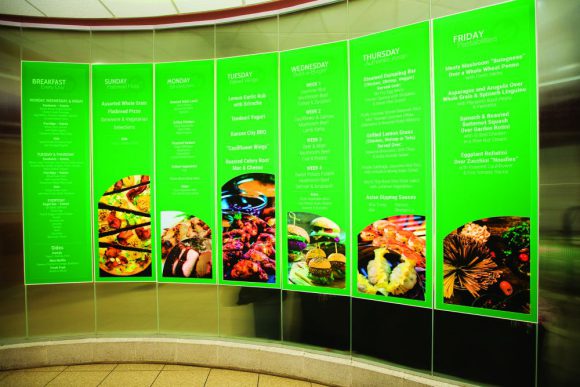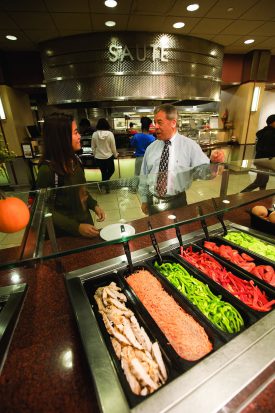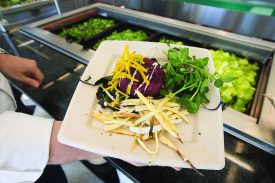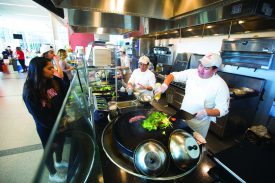
Full menu from Menus of Change.
No mystery meat here! Rutgers Dining Services serves up culinary delights that are healthy, minimally processed and fully customizable.

Joe Charette CC’77 and student Shannon Sy SAS’18 at Neilson Dining Hall.
What comes to mind when you think of a college dining hall? When Rutgers Dining Services executive director Joe Charette CC’77 looks back on his college dining experience it was something like this: a choice of two or three entrées each night, prepared ahead of time and loaded into pans on a buffet line. No one knew how long the pan had been out (or sitting in the back), and no one really knew what went into each recipe. Today? To say the story is quite different is an understatement.
Rutgers students have a choice of six entrées each night, but it doesn’t end there. “The cooks today are making food to order,” explains Charette, based on hundreds and hundreds of ingredients made available to students. That means students can collect the ingredients they like—grilled chicken and other proteins, a variety of fruits and vegetables, legumes, and more—and bring them to the Mongolian grill, sandwich station, sauté station or pizza oven to be turned into countless entrées that aren’t on the menu: wraps, salads, omelets, pizza, pastas, panini, anything they can dream up.
Plus, the ingredients may look a little different from what alumni remember. “In the last few years, student interest has grown immensely as far as where their food comes from, how far it has traveled, who grew it, how those people are treated, how the land and animals are treated, whether there are pesticides or GMOs used, and the nutritional value of the ingredients used,” Charette says. The dining team responds with new and innovative ingredients like vegan cheese as well as healthy alternatives like whole grain flours and plant-based proteins. “The health of the students is very important,” says Rutgers Dining Services chef manager Ian Keith. “They’re here to sharpen their minds, and we’re here to sharpen their nutritional needs.”

Harvest’s ruby Beet and Bean Burger with Golden Beet Crunch, Spicy Cress Salad, and Parsnip Baked Fries.
Innovative Ingredients
Designing a menu for nearly 70,000 students (not to mention the 32,000-plus faculty and staff that frequent the dining halls) is about more than just serving the masses. It’s also about reaching a nutritional benchmark, says Keith.
All of Rutgers’ dining halls have moved towards minimally processed real food. That is, foods made with whole ingredients that you’d likely find in your pantry or garden. But diners will also find alternative ingredients like vegan mayonnaise or chickpea flour. They can choose from a variety of milks, from cashew to hazelnut milk. What they won’t find is meat at the center of the plate. “We’re looking at plant-based proteins over animal proteins,” says Keith. “We want meat to be more of a condiment, so to speak, rather than the main component of the meal. We want plants to be the star of the stage.”
But how do you get college students to choose nutrient-rich plant-based foods over unhealthy comfort foods? It’s simple, says Keith: the trick is introducing these healthier ingredients into foods students already know and love.

Harvest at the Institute for Food, Nutrition, and Health.
Recently, Keith tested a macaroni and cheese made with whole grain pasta, soy milk, pureed celery root and vegan cheese made with pea protein. It might sound out of the box, but the student feedback was resoundingly positive. Such taste-testing is an invaluable tool, and one that the students are glad to be a part of.
In the spring of 2017, Rutgers embarked on a research project centered around a fast food favorite: the hamburger. Students were presented with four different samples: 100 percent beef, 60 percent beef and 40 percent mushroom, a 50/50 split between beef and mushroom, and a 40 percent beef and 60 percent mushroom option. As it turned out, students preferred the 50/50 burger the best. And, as a result, this new “Sizzling Scarlet” burger is served every Wednesday in the take-out sections of the dining halls as well as at Harvest, an eatery on the Cook campus, focused on whole, minimally processed food prepared with “from scratch” techniques. Alongside the Sizzling Scarlet burger, Keith also offers a vegetarian burger and a creative third option—it might be a turkey and zucchini burger, a cod and potato patty, a salmon burger, a beet and bean burger, a jasmine rice burger, the list goes on.
“Rutgers Dining serves 6.7 million meals a year. Because of our size, changes that we make have a big impact,” says Rutgers Dining Services nutritionist Peggy Policastro GSNB’93,’15. “If we can serve blended burgers instead of conventional burgers, that’s a lot of beef we’re saving. That’s a lot of vegetables added to students’ diets. And, it’s better for the environment because the carbon footprint of beef is significantly larger than that of vegetables.”
This type of swap is the cornerstone of Menus of Change, an initiative from The Culinary Institute of America that works to bring optimal nutrition, social responsibility, and environmental stewardship to the foodservice industry, including university dining halls. As a supporter of the pillars put forth by Menus of Change—indeed, this is an outlook that has guided Dining Services for years—Rutgers benefits from menu and recipe guidance as well as best practices that can help to make the menus even healthier for people and the planet.

Shivani Srivastava RBS’21 ordering from the Mongolian grill at Harvest.
Test Kitchen
Rutgers has recently joined the Menus of Change University Research Consortium, a select group of 40-plus universities that collaborate on best practices and research. Their goal? Choosing foods and creating menus that marry health, sustainability and culinary insight. Since Rutgers has been conducting surveys and research in its dining halls for years, this exclusive membership was an excellent fit. Here are just some of the research projects guided by Menus of Change principles and affecting true change in Rutgers dining halls:
Student surveys:
Understanding the common misconceptions students have about health and nutrition helps to guide Policastro’s education and outreach initiatives. So surveying the students is an invaluable tool. One survey was designed to find out whether students’ fruit deficiency stems from the fact that they pass on certain types, like canned or frozen fruits. After surveying student perceptions on fresh, frozen, and canned fruit, Policastro found that students perceive fresh fruits to be better in terms of taste, nutrition, and freshness—though, that’s not always the case. Another survey, centered on sugar content, asked students to rank the nutritional values of breakfast cereals. They weren’t always on the nose. By going right to the students with these types of questions, Policastro can see where the most education is needed and raise awareness accordingly.
Marketing insights:
Findings out of Stanford University showed that how you label a vegetable in the dining hall impacts its popularity among students. As it turns out, calling out nutritional value isn’t as motivating as providing a sensory-rich description that calls out texture or taste. Policastro wondered if the same could be said for a universally beloved dessert like chocolate cake.
Three descriptions were employed: a generic, a sensory-rich, and a nutrition description revealing the fat and caloric content. Would the students be interested in a smaller size of cake if the description was sensory-rich? “Yes,” says Policastro. “Students were just as willing to pay for a small piece of cake as a large one, if it’s marketed with a sensory description.” Ultimately, this kind of research can help Dining Services encourage better food choices, just by changing the ways they market a menu item.
The Power of Suggestion: Remember when fast food restaurants asked customers if they would like to super-size their order? Policastro wanted to know if the reverse was also true: would students lighten up their order if prompted? So she took to the Dunkin’ Donuts on Livingston Campus. Anytime someone ordered a latte, the person taking their order would ask if they would like to order a light version instead. When she examined the numbers, sales of light offerings drastically increased over the course of the study—and beyond. Considering that the light latte has 200 fewer calories than the regular, this represents a significant reduction in calories over time. In the end, the new foods in the dining hall and the way the team approaches nutrition are all part of a nationwide shift that Charette doesn’t see changing anytime soon. “I’ve been at Rutgers for 28 years, and I’ve seen a lot of trends come and go,” he says. “Today, America is finally changing the way it’s going to be eating, and that’s reflected in our students’ preferences—and in what we serve them.
Cupanion: Rutgers’ Reusable Bottle Program
A Cupanion bottle is a 16-oz. stainless steel bottle that can be used for both hot and cold beverages. The Rutgers University Student Assembly and The Daily Targum collaborated with Rutgers Dining Services on this new, innovative, sustainable way of handling takeout beverages by encouraging students to use reusable bottles, cutting down the waste of cups, lids, and straws.
Any student with a meal plan receives one during their first takeout meal at Brower Commons, Busch Dining Hall, Livingston Dining Commons, and Neilson Dining Hall, one bottle per student.
With each use, students scan the barcode with the Cupanion Barcode App to received points. Points can be earned to win gift cards to Amazon, Starbucks, and more!
Eco-Initiatives
As one of the largest university dining services departments in the nation, sustainability initiatives in Rutgers’ dining halls make a big impact. Here are just some of Dining Services’ eco-friendly initiatives:
Pulping food waste:
All the food waste in all the dining halls is pulped, reducing its overall volume by about 80 percent. Then, a local farmer picks up the pulp six times per week, to feed to his livestock. This saves countless tons of food from arriving in landfills.
Aerobic digesters:
At Harvest, all organic waste is fed into an aerobic digester, which liquefies it so it can be run down the drain instead of going to the landfill. In addition to Harvest, aerobic digesters can be found at the Neilson Dining Hall and Henry’s Diner, an eatery on the Livingston campus.
Local foods:
At Rutgers Dining Services, produce that’s in season in New Jersey must come from New Jersey. Local produce uses fewer resources to get to campus, helps the local economy, maintains open space, and provides students with fruits and vegetables at the peak of nutrition. All of the milk and chicken served at Rutgers is local, as is 80 percent of its pork and beef. Greenhouses on the corner of Dudley Road and College Farm Road provide wheatgrass and other greens, while the Student Farm at Rutgers Gardens provides produce for Harvest.

